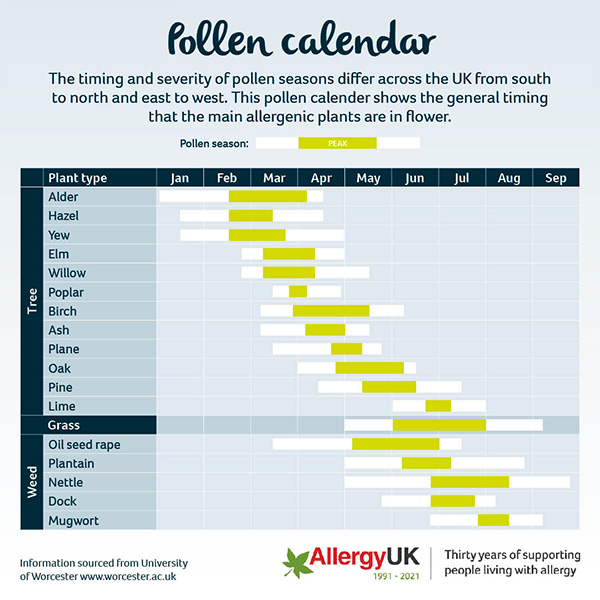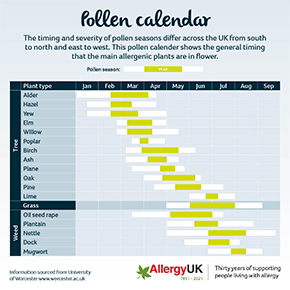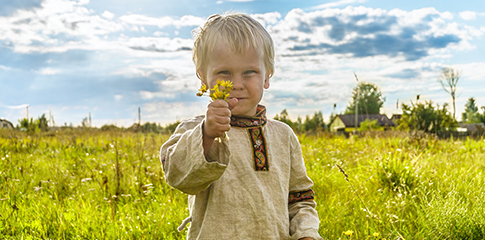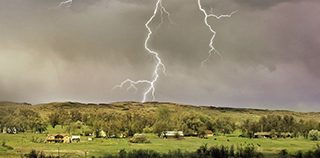In this article:
- Pollen type by season
- Pollen types by month
- When is pollen most common
Your seasonal guide to pollen
You may want to close your ears (and your watery eyes…) The UK pollen calendar isn’t a short one, so your hay fever and allergy symptoms can hang around from spring right through to winter. But here’s the better news: you probably won’t be allergic to all types of pollen. You might only be struck down by autumn allergies, or just suffer in summer.
The pollen calendar kicks off as early as January and continues through spring and summer well into autumn. In summer, allergy symptoms are more intense for lots of us. And while September marks the end of the pollen highs, you can still get hay fever in winter.
While hay fever peaks last around seven months, most of us won’t be dealing with allergies for all that time. Different months bring with them different pollens – each with their own symptoms. Take note of when your nose starts twitching and your eyes watering. Then look at our calendar – it’ll help you identify the pollen that’s causing your watery woes.
Tree pollen is the first to pitch up in the pollen calendar, with high numbers in late winter (February). Grass pollen peaks in summer (June), followed by weed pollen in autumn (October). In this guide, we’ve taken a closer look at the different pollens that come out to play as the seasons shift.
Pollen type by season
Tree pollen season is the first to arrive, landing in January – this is the beginning of the winter allergies season in the UK. Tree pollen lasts until June, when pine and plane pollen season ends.
Grass pollen season and oilseed rape both begin in spring – specifically, April. Grass pollen is one of the longest-running seasons, covering around six months from spring until autumn. Oilseed rape is one of the shortest, only lasting until the beginning of June.
Weed pollen season begins in spring and lasts until early autumn. It’s one of the last pollen seasons.
Spring (March, April and May)
Tree pollen, grass pollen and weed pollen are all kicking around in spring and summer – from March through to May. Tree pollen and grass pollen have peaks, so spring allergies and their symptoms could be more severe. Your spring hay fever symptoms might include painful sinuses and a cough.
Summer (June, July and August)
Summer allergies bring hay fever symptoms with the peak in grass and weed pollen. Summer allergy symptoms are intense for some of us, so your itchy and watery eyes could be worse, especially when you spend more time outside or near cut grass.
Autumn (September, October and November)
Hay fever in autumn drops as pollen season slows down – around the beginning of September in the UK. That said, autumn allergy symptoms can still cause you trouble due to both late-release weed pollen and other causes, such as mould.
Winter (December, January and February)
Tree pollen starts its season in January. This means you could mistake hay fever in winter for a cold as your symptoms include a snotty or blocked nose, sore throat, cough and itchy eyes. Winter pollen is released in January in the UK – so hay fever can cause you many of the same symptoms in winter as at any other time of the year.
Pollen types by month
Don’t let your allergies be the boss of you – know when the different types of pollen kick off. Don’t forget you can use Your Pollen Pal to check for pollen areas near you. And you can also find out what type of pollen affects you with our hay fever and allergy test.


January
While this month has a low pollen count, tree pollen is on the up – specifically hazel, yew, alder and willow trees. This means you can get hay fever in winter, including in the depths of dreary January. However, you may mistake your symptoms for a winter cold.
In winter, hay fever can cause you:
- Sneezing and blocked nose
- Itchy eyes, throat and ears
- Difficulty breathing
Up to 80% of people with asthma could suffer from winter allergies, according to Asthma UK.
February
Seven tree pollen variants start causing havoc in February. As well as hazel, yew, alder and willow, we also see ash, elm and birch pollen join the party. It’s in this month we see our first peak from the winter pollen season, with hazel and yew hitting their highs until mid-March.
March
Poplar, oak and plane pollen say hello in March. Hay fever this month rises due to elm, alder, willow and poplar pollen – but it’s also the end of hazel pollen.
Winter tree pollen allergies can start to have a big impact in March, so you might also notice:
- Watery or itchy eyes
- Headaches
- A reduced sense of smell
- Disrupted sleep and tiredness
April
Pine pollen shows its face in April while ash, birch, oak and plane all peak this month. April may be known for its showers, but it’s also when tree pollen season finally starts to come to an end. Just birch, oak, pine and plane remain from the tree-pollen family. Grass, oilseed rape and weed pollen make their entrance, though, with nettle and plantain beginning their pollen season.
May
This month is THE BIG ONE when it comes to tracking pollen. Dock and lime pollen can start triggering your hay fever in May as they begin their season. Pine and oilseed rape both peak and end within the month. Oak and plane climb down from their peak – but grass pollen begins hitting its highs. If you have a birch pollen allergy, you’ll be able to breathe a (snotty) sigh of relief as birch pollen season is over.
June
Oak, pine, oilseed rape and plane pollen say ‘see ya’ come the end of June, while grass pollen goes from strength to strength. Mugwort pollen season also kicks off.
You may be confused whether your symptoms match a summer cold or hay fever. At this time of year, allergy symptoms can be high, but viral infections can still be around too. In general, a cold normally clears up within a couple of weeks, while hay fever may bother you for a month or more. The symptoms are also slightly different – with summer hay fever, you might experience itchy sinuses, but this is less likely with a summer cold.
July
The grass and nettle pollen peak ends in July, while mugwort begins its peak. Lime pollen season also takes a hike. Since many of us experience grass pollen allergies in summer (grass is the most common trigger of pollen allergies, according to Allergy UK) late July is a time to celebrate.
If your symptoms pick up in late summer, mugwort could be your allergy enemy. It’s more common in the East Midlands, including Leicestershire and Rutland. In Scotland, you’ll mostly find it close to the coast.
August
We’re finally starting to see less pollen as summer draws to a close. Thankfully, dock and plantain pollen season end this month.
At the very end of August, there are some weed pollen allergies that might still cause your hay fever symptoms to kick off:
- Ragweed
- Dock
- Mugwort
- Nettle
- Oilseed rape
You might be tempted to hang washing outside in the August sunshine, but weed pollen can cling to your laundry as it dries. Throwing on some sunglasses can help to keep weed pollen out of your eyes.
September
And relaaaaaax. Grass and nettle pollen seasons end. It’s the end of hay fever season! Open those windows wide. Breath in the fresh air. We can all head outside with zero worries about snotty noses and itchy eyes.
October
Ah, we spoke too soon… Although hay fever season has taken a hike, autumn allergies in the UK can be triggered by pollen. Ragweed releases pollen well into October, causing the classic sneezing and itchy eyes. About 75% of us who are allergic to other types of pollen also have a sensitivity to ragweed. So if you find yourself feeling irritated by hay fever symptoms in autumn, this could be the culprit.
November
By November, pollen release is low in the UK, but some weeds do continue to release pollen now. Mould also releases airborne spores in the autumn – so this could be the cause of your late autumn allergies. Check out your bathroom and other damp areas around your home to see if you’ve any mould growth.
December
By December, weed pollen release has finished, but – you guessed it – some trees may start to release early pollen. Hay fever in winter is often a response to tree pollen – alders, hazels and yew trees are gearing up to release pollen in January.
Pollen release is at its lowest in December, so your hay fever symptoms may be due to something else such as a dust mite allergy.
When is pollen most common?
While there are many different hay fever causes, they all fall under one of three main pollen types: tree, grass and weeds. While there’s some crossover of the three variants, they each have their own specific hay fever season in the UK. Don’t know what type of pollen affects you? Take our hay fever and allergy test.
If you’re planning on spending time outdoors, especially during peak pollen season, read our tips from Allergy UK to help manage your seasonal allergy symptoms.
The content should not substitute medical advice from your personal healthcare provider. Please consult your healthcare provider for recommendations/diagnosis or treatment












